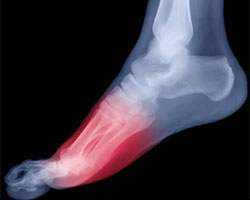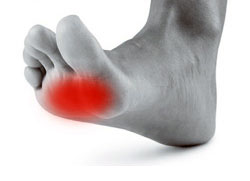- Home
- Foot & Ankle Conditions
- Metatarsalgia (ball of foot pain)
Metatarsalgia: symptoms, causes and treatments
- Published 6/1/2018
- Last Reviewed 11/20/2024

What is Metatarsalgia?
Metatarsalgia often referred to as "ball of the foot pain" or a "stone bruise" is not so much a condition but a general term describing a group of foot problems whose symptoms are caused by several conditions.
In some cases, there can be more than one condition causing metatarsalgia symptoms. This is just one of several reasons why a proper diagnosis can be challenging and why the experience of your doctor is such a critical part of diagnosis and getting a successful treatment plan from the start.
-
Foot and Ankle Surgeon at University Foot and Ankle Institute
Dr. Justin Franson, DPM, is a Board Certified Podiatric Foot and Ankle Specialist and Diplomate of the American Board of Podiatric Surgery. He attended the School College of Podiatric Medicine in Chicago, graduating in 2001. Dr. Franson then accepted a three-year residency program at the Greater Los Angeles VA and UCLA County Hospital.
Dr. Franson specializes in several areas including total ankle replacement and sports medicine. Treating athletes and weekend warriors like himself brings him a lot of joy. Dr. Franson keeps active with running marathons, triathlons, hiking, basketball, and golf.
Metatarsalgia articles from our blog
 University Foot and Ankle Institute is an excellent comprehensive facility. Dr. Briskin is a wonderful Doctor and the staff is ...Lisa K.
University Foot and Ankle Institute is an excellent comprehensive facility. Dr. Briskin is a wonderful Doctor and the staff is ...Lisa K. Please provide handicap parkingBarry S.
Please provide handicap parkingBarry S. Dr. Ambibola Johnson is awesome!Laurie S.
Dr. Ambibola Johnson is awesome!Laurie S. I appreciate the care and timeliness of all my appointments I’ve had at UFAI. Gray, Lydia and the staff all are wonderful. Lydi...Edelmira G.
I appreciate the care and timeliness of all my appointments I’ve had at UFAI. Gray, Lydia and the staff all are wonderful. Lydi...Edelmira G. Very greatfull for the doctor and stuffJesus M.
Very greatfull for the doctor and stuffJesus M. Doctor was very caringBrigitte S.
Doctor was very caringBrigitte S. 1 ) the waiting time to see my doctor last lest than 10 minutes.
1 ) the waiting time to see my doctor last lest than 10 minutes.
2 ) l found my doctor very knowledgeable and
very well educate...Bahram F. I have been a patient for over 10 years and always get the best treatment from everyone working at UF&AI.Judith S.
I have been a patient for over 10 years and always get the best treatment from everyone working at UF&AI.Judith S. Everyone is very nice and efficient-
Everyone is very nice and efficient-
Especially Dr Kelman. He takes very good care of me!!Claudia K. Great costumer service.
Great costumer service.
Prompt and efficientDean W. No . I’m pleased with the care .Michael P.
No . I’m pleased with the care .Michael P. Appreciate the professionalism and expertise, as well as the caring.Stella G.
Appreciate the professionalism and expertise, as well as the caring.Stella G.



